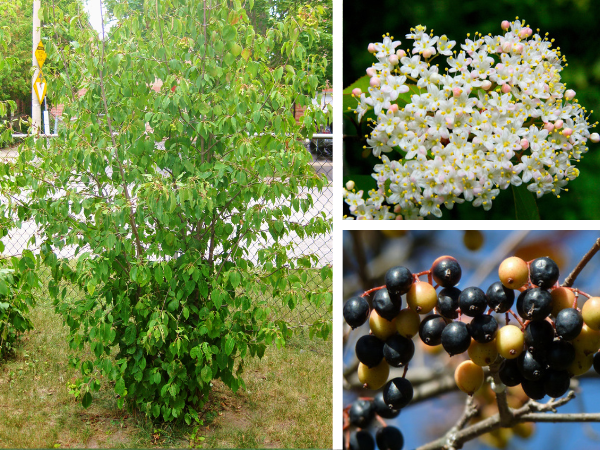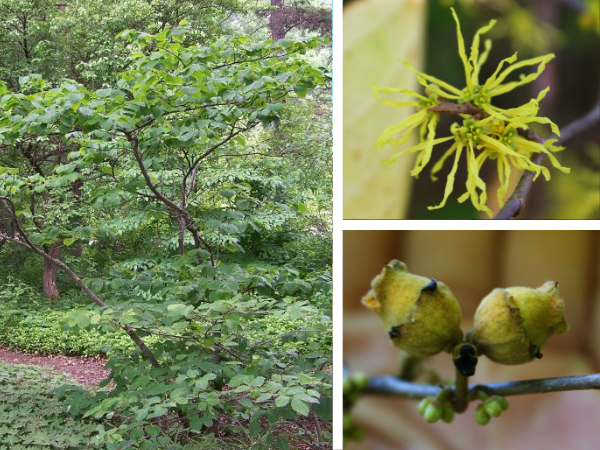Here are four native shrub species that will look beautiful in your yard and offer a much-needed fall snack for local birds - and perhaps for you too!
Common Elderberry (Sambucus canadensis)
Common Elderberry is an attractive shrub and a huge hit with birds. It grows six to eight feet tall and wide, has large clusters of fragrant white flowers in summer, and bright green compound leaves that turn yellow in fall. It grows best in full to partial sun and can handle a wide range of soil types.
Common Elderberry produces a large quantity of tiny drupes (berry-like fruits with hard stones in the middle) gathered in large clusters. The dark purplish-black drupes mature in late summer/early fall, and are eaten by over 45 bird species, including Cedar Waxwings, Eastern Bluebirds, Gray Catbirds, Indigo Buntings, Rose-breasted Grosbeaks and Scarlet Tanagers. While edible to humans, the drupes are bitter and best used for baking in yummy pies or jams.

Nannyberry (Viburnum lentago)
Another magnificent shrub for fall fruit is Nannyberry. It grows to 15 feet tall and eight feet wide, blooms with clusters of small white flowers, and has dark green simple leaves that turn to shades of yellow, red, and purple in fall. It grows well in both full or partial sun and can handle a range of soil types.
Nannyberry produces large groups of small, bluish-black drupes, which mature in late summer/early fall and persist into winter. This makes them an especially good food source for migrating and winter residing birds, like Cedar Waxwings, Eastern Kingbirds, Gray Catbirds, Indigo Buntings, Northern Flickers and Purple Finches. Nannyberry fruit is edible for humans and can be eaten when ripe right off the shrub or used in baking – if you can get any before the birds do!

Black Chokeberry (Aronia melanocarpa)
Black Chokeberry, with a mature size of five to eight feet tall and wide, is a perfect shrub for smaller yards. It has small clusters of white flowers with pink centres, and simple dark green leaves that turn beautiful shades of orange and red in fall. It grows best in full or partial sun, can handle a range of soil types, and can be planted in wet conditions.
Black Chokeberry has fleshy, dark bluish-black fruit that are bitter when raw, so for humans, they are best used for baking. They mature in late summer/early fall and persist into winter, making them very valuable food sources for winter birds like Blue Jays, Cedar Waxwings, Northern Cardinals, Northern Mockingbirds and Wild Turkeys.

Common Witchhazel (Hamamelis virginiana)
Common Witchhazel is a winner for providing late fall/winter food for birds! It grows to a mature size of 15 feet tall and wide and has the distinctive characteristic of bearing its ribbon-like yellow flowers in late fall, often after leaf drop! The simple green leaves give way to beautiful shades of yellow in fall. Witchhazel prefers full to partial sun and soil types from sand to loam to light clay.
The fruits are small brown woody capsules, which mature in late fall and persist into the next growing season. These woody fruit capsules may not be suitable for humans, but they provide invaluable winter food for birds like American Goldfinches, Black-Capped Chickadees, Northern Cardinals, Ruffed Grouses and Wild Turkeys.

Attract all the beautiful birds by planting these fall-fruiting shrubs for less through our subsidized Backyard Tree Planting Program! Check out our Homeowners page to get started on tree planting and our Shrubs, Garden Kits and Pawpaws page to order shrubs.
Justin Lewis is the Marketing and Communications Lead at LEAF.
The #BackyardBiodiversity campaign is a partnership initiative with the Toronto Wildlife Centre and is supported by Ontario Power Generation.
LEAF offers a subsidized Backyard Tree Planting Program for private property. The program is supported by the City of Toronto, the Regional Municipality of York, the City of Markham, the Town of Newmarket, the Regional Municipality of Durham, the Town of Ajax, the Township of Brock, the Municipality of Clarington, the City of Oshawa, the City of Pickering, the Township of Scugog, the Town of Whitby, Ontario Power Generation, Ontario Trillium Foundation and GrandTrees/Canadian Trees For Life.
